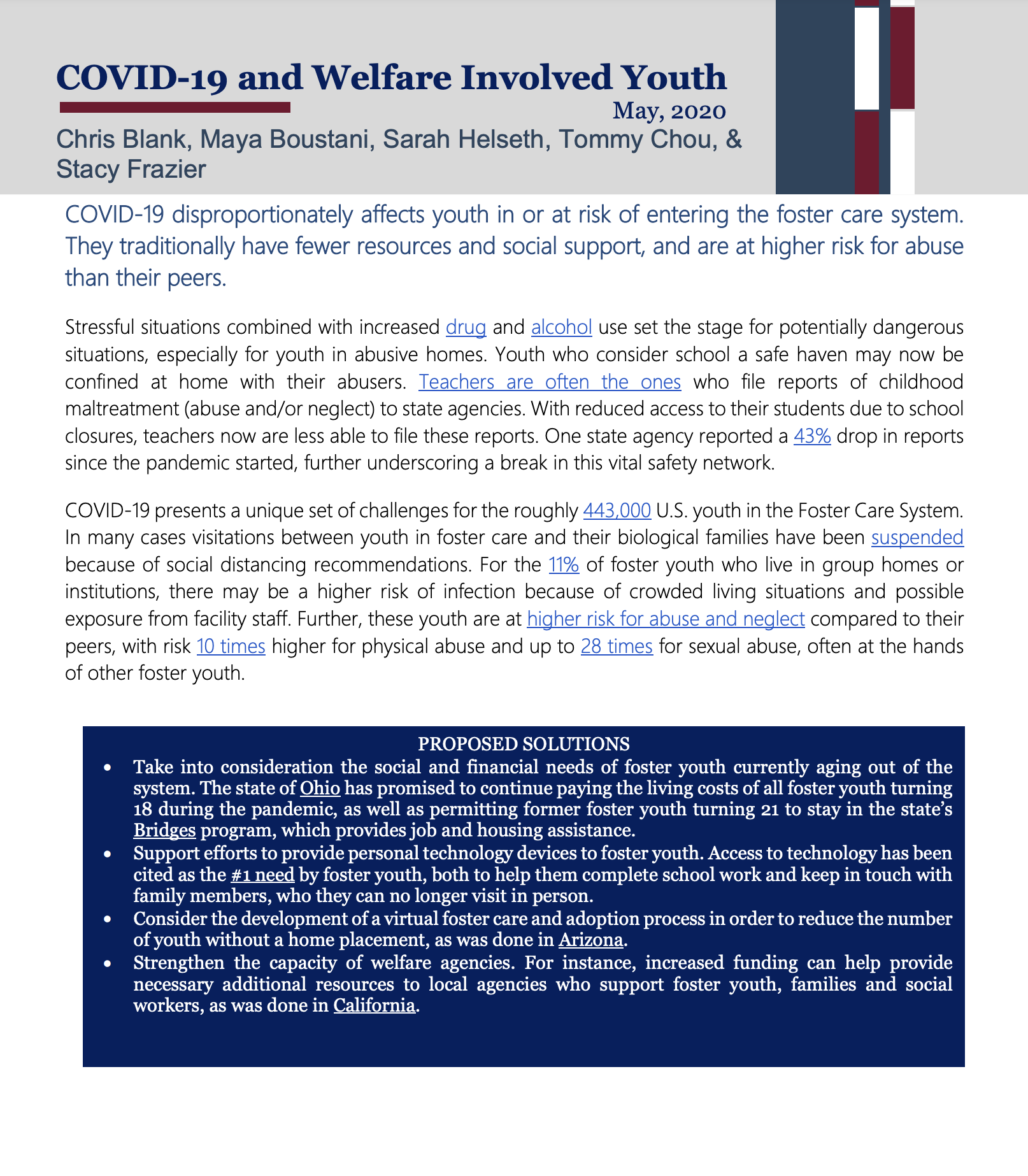
COVID-19 disproportionately affects youth in or at risk of entering the foster care system. They traditionally have fewer resources and social support, and are at higher risk for abuse than their peers.
Stressful situations combined with increased drug and alcohol use set the stage for potentially dangerous situations, especially for youth in abusive homes. Youth who consider school a safe haven may now be confined at home with their abusers. Teachers are often the ones who file reports of childhood maltreatment (abuse and/or neglect) to state agencies. With reduced access to their students due to school closures, teachers now are less able to file these reports. One state agency reported a 43% drop in reports since the pandemic started, further underscoring a break in this vital safety network.
COVID-19 presents a unique set of challenges for the roughly 443,000 U.S. youth in the Foster Care System. In many cases visitations between youth in foster care and their biological families have been suspended because of social distancing recommendations. For the 11% of foster youth who live in group homes or institutions, there may be a higher risk of infection because of crowded living situations and possible exposure from facility staff. Further, these youth are at higher risk for abuse and neglect compared to their peers, with risk 10 times higher for physical abuse and up to 28 times for sexual abuse, often at the hands of other foster youth.
Proposed Solutions
- Take into consideration the social and financial needs of foster youth currently aging out of the system. The state of Ohio has promised to continue paying the living costs of all foster youth turning 18 during the pandemic, as well as permitting former foster youth turning 21 to stay in the state’s Bridges program, which provides job and housing assistance.
- Support efforts to provide personal technology devices to foster youth. Access to technology has been cited as the #1 need by foster youth, both to help them complete school work and keep in touch with family members, who they can no longer visit in person.
- Consider the development of a virtual foster care and adoption process in order to reduce the number of youth without a home placement, as was done in Arizona.
- Strengthen the capacity of welfare agencies. For instance, increased funding can help provide necessary additional resources to local agencies who support foster youth, families and social workers, as was done in California.
The Research-to-Policy Collaboration (RPC) works to bring together research professionals and public officials to support evidence-based policy. Please visit their website to learn more.
Key Information
RPC Website
Research-to-Policy Collaboration
More RPC Resources
RPC Resources
Publication DateMay 1, 2020
Resource TypeWritten Briefs
Share This Page
COVID-19 disproportionately affects youth in or at risk of entering the foster care system. They traditionally have fewer resources and social support, and are at higher risk for abuse than their peers.
Stressful situations combined with increased drug and alcohol use set the stage for potentially dangerous situations, especially for youth in abusive homes. Youth who consider school a safe haven may now be confined at home with their abusers. Teachers are often the ones who file reports of childhood maltreatment (abuse and/or neglect) to state agencies. With reduced access to their students due to school closures, teachers now are less able to file these reports. One state agency reported a 43% drop in reports since the pandemic started, further underscoring a break in this vital safety network.
COVID-19 presents a unique set of challenges for the roughly 443,000 U.S. youth in the Foster Care System. In many cases visitations between youth in foster care and their biological families have been suspended because of social distancing recommendations. For the 11% of foster youth who live in group homes or institutions, there may be a higher risk of infection because of crowded living situations and possible exposure from facility staff. Further, these youth are at higher risk for abuse and neglect compared to their peers, with risk 10 times higher for physical abuse and up to 28 times for sexual abuse, often at the hands of other foster youth.
Proposed Solutions
- Take into consideration the social and financial needs of foster youth currently aging out of the system. The state of Ohio has promised to continue paying the living costs of all foster youth turning 18 during the pandemic, as well as permitting former foster youth turning 21 to stay in the state’s Bridges program, which provides job and housing assistance.
- Support efforts to provide personal technology devices to foster youth. Access to technology has been cited as the #1 need by foster youth, both to help them complete school work and keep in touch with family members, who they can no longer visit in person.
- Consider the development of a virtual foster care and adoption process in order to reduce the number of youth without a home placement, as was done in Arizona.
- Strengthen the capacity of welfare agencies. For instance, increased funding can help provide necessary additional resources to local agencies who support foster youth, families and social workers, as was done in California.
The Research-to-Policy Collaboration (RPC) works to bring together research professionals and public officials to support evidence-based policy. Please visit their website to learn more.

Key Information
RPC Website
Research-to-Policy Collaboration
More RPC Resources
RPC Resources
Publication DateMay 1, 2020
Resource TypeWritten Briefs
Share This Page
LET’S STAY IN TOUCH
Join the Evidence-to-Impact Mailing List
Keep up to date with the latest resources, events, and news from the EIC.




